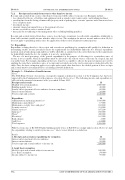Page 566 - SAIT Compendium 2016 Volume2
P. 566
IN 64 (3) Income Tax acT: InTeRPReTaTIon noTes IN 64 (3)
7.1.2 Receipts and accruals from sources other than levy income
Receipts and accruals from a source other than levy income will be subject to income tax. Examples include –
• fees charged for the use of facilities and equipment such as squash courts, tennis courts, and washing machines;
• rental income from the letting of immovable property such as parking bays, servants’ quarters and a demarcated area
for a cell phone mast;
• investment income;
• amounts charged on unpaid levies or late payment of levies;
• income received for services rendered; and
• nes paid for not adhering to the management rules excluding building penalties.
Receipts and accruals derived from these sources (less the basic exemption), less allowable expenditure attributable to them, will constitute taxable income which is subject to tax. The exemption for interest income under section 10(1)(i) does not apply to qualifying entities since the application of that section is limited to natural persons.
7.2 Expenditure
Expenditure relating directly to the receipts and accruals not qualifying for exemption will qualify for deduction in determining taxable income provided it meets the requirements for deductibility under the Act. General expenditure incurred, such as bank charges and audit fees, will be allowable as a deduction to the extent that it meets the requirements for deductibility under the Act, for example, it is not of a capital nature.
The use of a xed percentage of the general expenditure for the purpose of allocating it to a particular source of income is not acceptable. General expenditure must be allocated to the various sources of income on a logical, fair and reasonable basis. For example, depending on the facts, it may be acceptable to allocate the general expenses pro rata by applying the ratio that a particular source of receipts and accruals bears to the total receipts and accruals derived by the entity. Since the basic exemption applies to receipts and accruals other than levies, the taxable portion of those receipts and accruals must be determined before calculating allowable deductions.
Example 3 – Calculation of taxable income
Facts:
The XYZ Home Owners’ Association, a non-pro t company as de ned in section 1 of the Companies Act, has been approved by the Commissioner for the purposes of section 10(1)(e)(i)(cc). The following income and expenditure is
re ected in the nancial statements for the year ended 30 June 2015:
Receipts and accruals
Monthly levies from members
Building penalty levies
Penalty on late payment of levies and nes for non-compliance Interest on investments
Total receipts and accruals
Expenditure
Administration and management fees* Maintenance guard house* Maintenance security fence and gates* Security services*
Garden services* Insurance* Water* Electricity* Bank charges Audit fees
Total expenses
2
2 1
2
R
000 000 40 000 80 000 20 000
140 000
R
180 000 15 000 102 800 234 000 107 200 160 000 200 000 195 000 2 000 12 000 208 000
Note: Levy income of R2 000 000 plus building penalty levies of R40 000 are exempt under section 10(1)(e)(i) and the expenditure relating to such levy income (see * above) is not allowed as a deduction.
Result:
1. Receipts and accruals not qualifying for exemption R
Interest on late payment of levies and nes Interest on investments
Total receipts and accruals subject to income tax
2. Apply basic exemption
Gross receipts and accruals subject to income tax Less: Basic exemption
Income subject to income tax
80 000
20 000 100 000
100 000 (50 000)
50 000
558
saIT comPendIum oF Tax LegIsLaTIon VoLume 2


